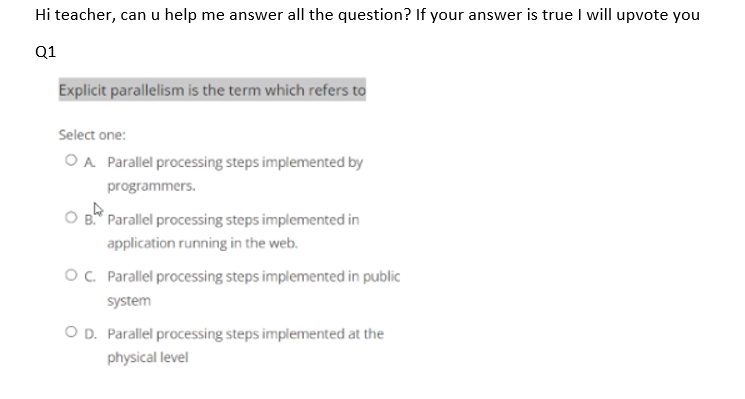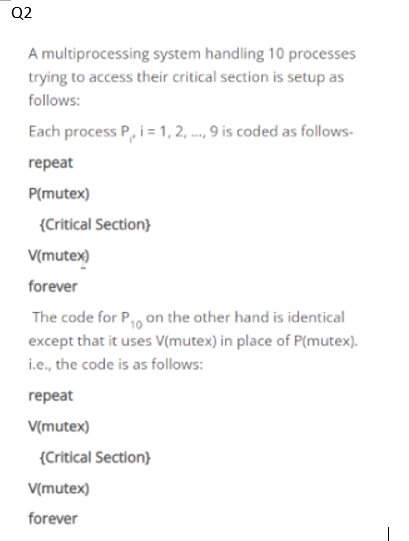





Hi teacher, can u help me answer all the question? If your answer is true I will upvote you Q1 Explicit parallelism is the term which refers to Select one: O A Parallel processing steps implemented by programmers. OB. * Parallel processing steps implemented in application running in the web. OC Parallel processing steps implemented in public system OD. Parallel processing steps implemented at the physical level Q2 A multiprocessing system handling 10 processes trying to access their critical section is setup as follows: Each process P, i = 1, 2, ..., 9 is coded as follows repeat P(mutex) {Critical Section} V(mutex) forever The code for P, on the other hand is identical except that it uses V(mutex) in place of P(mutex). i.e., the code is as follows: repeat V(mutex) {Critical Section) V(mutex) forever Study the pseudocodes closely and determine which of the statement(s) below are TRUE about this system? I. The maximum number of process can enter the critical section at the same time is 10 II. The system will never allow more than 1 process to enter their critical section at any time. III. Every time P10 execute its code, it will allow two other process in queue to enter their critical section. IV. The system involves busy-waiting technic. Select one: O AI and III only OB. I only OC. I,III and IV only OD. II and IV only Q3 A multiprocessing system handling 9 processes trying to access their critical section is setup as follows: Each process P, i = 1, 2, ..., 9 executes this code: repeat P(mutex) {Critical Section) V(mutex) forever Study the pseudocodes closely and determine which of the statement(s) below are TRUE about this system? 1. Only one process can enter its critical section at one time while the rest will be put in a queue. II. there are two binary semaphore used in the code. III. all processes share the same semaphore. IV. Eventually all process can enter their critical section in a mutually exclusive fashion. Select one: O A I, II and IV only . I and II only OC. I,II,III and IV only OD. II, III and IV only OE. None of the above is TRUE Q4 A typical magnetic disk reader has the following specifications: i. Rotational speed is 10000 rotations per minute (RPM) ii. transfer rate of 50 x 106 bytes/sec. iii. the average seek time of the disk is twice the average rotational delay iv. the controller's transfer time is 10 times the disk transfer time. What is the average rotational delay of the disk? Select one: O A. (0.5 x 60/10006) msec O B. (0.5 x 60/10000) x 1000 msec OC (0.3 x 50 x 106) msec OD. ((60/10000) x 1000) msec












